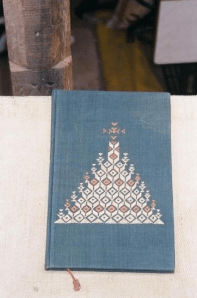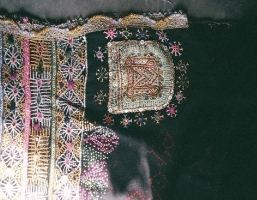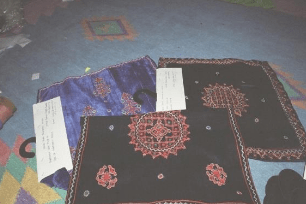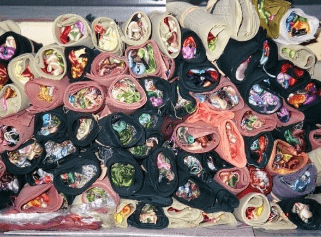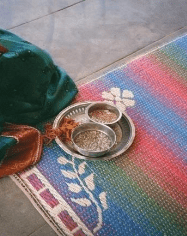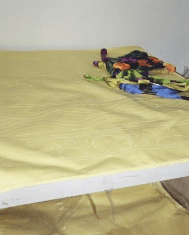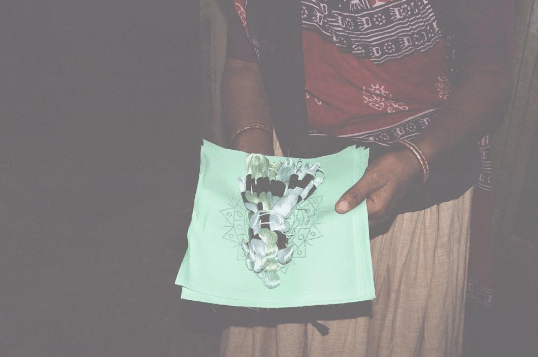There are many specialized regional embroideries including Soof, Rabari, Pako, Mochi barat, Ahir, Aari, Mutwa, Sujni, Zardoziand many more, which are documented separately. This document refers to a broad overall process that is common to all of these and falls under the broader classification of Hand embroidery.
Embroidery is traditionally done by women from villages. The embroideries of each sub-region illustrate and elaborate this cultural division. While some embroidery styles are predominantly regional others are specific to a community.
History of Hand embroidery
Embroidery has a very long history in the Indian sub-continent. The earliest Indian needles were excavated at Mohenjadaro and can be dated to about 2000 BC. The patterns of textiles represented in early sculptures suggest that sophisticated weaving, printing and embroidery techniques were known from a very early period.
In traditions of Embroidery and dress, one can ‘read’ the complicated ethnic and caste relationships that characterize the social matrix of the people. An embroidery style is a manifest expression of the world of the artisan.
Each type represents a particular people or group of people in one place at a point in time. Each unique combination of stitches, motifs, patterns and colours conveys the historical experiences of the people who make and use it.
Skills and patterns are transferred through generations over hundreds of years. Thus the distinctive styles of domestic embroidery vary from caste to caste rather than from village to village.
Embroidery plays a major ritual role in marriage. In many communities, a girl prepares items for her trousseau throughout her childhood. Her ability as an embroiderer is important in her gaining a husband, and the embroidered trousseau is publicly displayed to demonstrate her skill and the textile wealth she is bringing to the marriage.
The embroideries mainly consist of a lifetime’s supply of clothing for the bride and gifts for the family (embroidered beetle bag, cover for her kohl box, embroidered cover for a comb for her husband, linen for the bed).
Apart from contributing to the substantial economic exchange required for marriage, embroideries created by village women bring a spark of color into objects of their every day and ritual use.
The colorful sparkling garments and household decorations, bags, animal trappings and even games -portable objects suited to mobile life -have traditionally been used during auspicious occasions, to honor deities, or to generate wealth.
Using hours of time available after essential chores, women pastoralists, agriculturists and artisans -Hindu, Muslim, Jain -all transform inexpensive available cloth and thread into highly valued currency.
Region and Location
In spite of commercialization in some areas and at different periods, the regional characteristics of hand embroidery are distinctive.
Even today with Indian folk traditions everywhere in decay, it is still possible to identify embroidery styles from different centers: the satin stitch and cross stitch embroidery from Sindh, Phulkari from the state of Punjab, chain stitch work of Kutch and Kathiawar and Kantha of Bengal.
Each of these regional styles has its distinctive combination of techniques, colour and designs and each has its counterpart in commercial embroidery produced for the market.
The various regions famous for embroideries are:
GUJRAT (Soof, Rabari, Pako, Mochi barat, Ahir, Aari, Mutwa)
RAJASTHAN Aari
HIMACHAL PRADESH Chamba rumal embroidery
KATHIWARA ari
UTTAR PRADESH Chikankari, Zardozi
BENGAL Kantha
KASHMIR Kashida, Rafugiri, Chain stitch
PUJAB Phulkari
KARNATAKA Kasuti
BIHAR Sujni
In Gujarat, Kutch is the place where these communities and their beautiful embroideries can be found. Aari embroidery is done in Gujarat, Kashmir and Uttar Pradesh.
The north-west of the Indian subcontinent (Sindh and Gujarat) was the main area for several centuries which used the hook to make chain stitch embroideries. Now it is used in several parts of India. Earlier silk thread was used for this level of skilled work. In Kashmir wool is used and the cloth is cotton orfelt.
Other communities may copy some of these ethnic styles. An examination of embroidery styles practiced by different communities illuminates the identity of particular communities in relationship to the society at large. Communities that are interdependent tend to share embroidery styles. Communities which are culturally separate, like the Rabar is, practice unique emblematic ethnic styles.
Yet, when subgroups of Rabar are integrated into the local society they adapt regional embroidery styles too. Gujarat and Western Rajasthan are the main areas where Soof, Pakko, Jat, Ahir, Mochi, Kharek and Rabari embroideries are done. This is a region of cut as opposed to draped clothing.
The women make skirts, blouses and head clothes for themselves, coats and caps for their children, bags, quilts, small covers for food, hangings for festivities and marriage.
Producer Communities
To artisans embroidery communicates self and status, and creates bonds within society. Difference in embroidery style creates and maintains distinctions that identify community, sub community and social status within community.
Raw Materials
Cotton and silk threads of various colors
Mirrors, beads, very fine metal wires (silver, gold, copper etc)
Fabric (cotton, silk or any other), leather etc
Fish skin, teeth, bones, feathers, horn shells, beetle wings, tassels, coins, buttons
With the entry of embroideries into the market, the raw materials used have undergone
a change. Customers demand qualities such as colour fastness and standardization. Anchor threads have gained wide currency. They are easily available, color fast and come in skeins, which reduce chances of the thread getting entangled. These are cotton threads. At times satin thread is also used.
Tools
Needles: Various sizes and types of needles are used as required.
Thread: Cotton, linen, wool, gold, silver and silk threads are used
Hook
Making of the craft
Embroidery involves the embellishment of any material with pattern or design with a needle. The embellishment is made on an existing fabric with accessory threads and sometimes with other material. Such decorative elements as fish skin, teeth, bones, feathers, horn shells, beetle wings, tassels, beads, coins, buttons, metal and mirrors have all at some time or place been used in this way.
1)A material (fabric, leather etc) is selected as the base as per the requirement.
2)The designs were traditionally freely drawn or worked by counting threads. Nowadays designs are often transferred on the base material with the help of tracing paper or carbon paper, so as to create a large number of pieces of one particular design and to maintain uniformity.
3)Patterns are created with the help of needle and thread. Sometimes even a hook is used to embroider. The thread used can be silk, cotton, linen, wool, gold or silver.
4)These patterns, motifs and colors are usually very specific to the particular region if created for the local market or for personal use. For the outside market, variations in colors and motifs are made to suit buyer requirements.
A specific stitch or combination of stitches is used to decorate the base material. A separate technique exists for metal or other precious threads, for non pliable materials such as quills and for narrow decorative trims like cords and braids.
These are laid on the fabric and couched down by stitching with another thread, so that none of the decorative material is hidden underneath the cloth. Embroidering can do value addition on a range of products, not just those for the community or local needs.
Products and their use
Garments: Saris, blouse, kurtas Accessories: Purses, caps, embroidered leather chairs, stools etc


